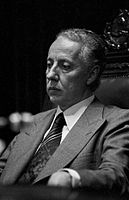Argentine general election, 1983
|
|
|||||||||||||||||||||||||||||
|---|---|---|---|---|---|---|---|---|---|---|---|---|---|---|---|---|---|---|---|---|---|---|---|---|---|---|---|---|---|
|
|||||||||||||||||||||||||||||
|
|||||||||||||||||||||||||||||

Most voted party by province.
|
|||||||||||||||||||||||||||||
|
|||||||||||||||||||||||||||||
Reynaldo Bignone
none (de facto regime)
Raúl Alfonsín
Radical Civic Union
The Argentine general election of 1983 was held on 30 October and marked the return of constitutional rule following the self-styled National Reorganization Process dictatorship installed in 1976. Voters fully chose the president, governors, mayors, and their respective national, province and town legislators; with a turnout of 85.6%, it produced the following results:
aAbstentions.
Electoral system: Proportional representation by districts according to the D'Hondt method. Seats are divided among those lists of candidates from parties or electoral alliances that obtain at least 3% of the electoral census or working electoral of the district.
Few believed, as morning headlines on March 24, 1976, announced a military coup d'état against President Isabel Perón, that most of the problems of financial instability, inflation, endemic corruption, international isolation and violence that typified her last year in office would be worsened by the self-appointed National Reorganization Process. As that regime's third dictator, General Leopoldo Galtieri, awoke in the early hours of June 18, 1982 to find a letter requesting he resign, however, he had no doubt that the Process had run its course. Against the wishes of Galtieri's commanders, the Joint Chiefs chose Army General Reynaldo Bignone not so much the new President as the usher towards a democratic transition, which President Bignone announced would take place in March 1984. Inheriting an economy struggling under crushing interest rates imposed by the Central Bank Circular 1050, Bignone's new president of the institution, Domingo Cavallo, rescinded the policy in July, a move towards economic liberalization complemented by Bignone's restoring a limited right of assembly and free speech. Argentina's wide array of political parties, jointly pressing for elections through a "Multiparty" convened by centrist UCR leader Ricardo Balbín in 1981, geared for the imminent return to democracy.
...
Wikipedia


